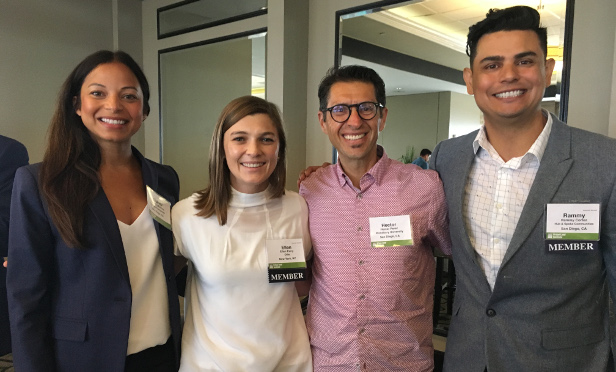
SAN DIEGO—From micro-apartments to co-living models and live/work spaces, smaller units are actually preferable to traditional-sized apartments and offices in many ways, said panelists at a recent ULI breakfast event. At the ULI San Diego-Tijuana District Council event, hosted by the ULI Young Leaders Group and moderated by Rammy Cortez, development partner with Hub & Spoke Communities speakers said in urban areas throughout the US, developers are disrupting traditional norms by embracing these more-diminutive spaces, and so are the individuals who are living in them.
While some may see co-living and micro units as dorm living for adults, panelist Ellen Parry said that her company's units feel elegant and aspirational, with a hotel environment, and feature transformational furniture for privacy and effective use of space. Parry's company, Ollie, manages co-living spaces in major urban areas on both coasts.
According to Sidnev Muldrow, an agent with Cantor Properties, her clients appreciate the lifestyle that the new forms of housing offer. Muldrow has rented to tenants units as small as 250 square feet in San Diego. While most of her clients are Millennials, she also rents to Navy clients and transplants from other urban places. In her experience, it comes down to location versus generation when choosing the emerging housing options, she said.
Affordability and architecture are primary drivers for the individuals living in Hector Perez's developments. The architect with the Red Office builds housing that attracts a creative group of people who often have families. His designs feature open floorplans that are naturally ventilated and lighted, allowing the occupant to appropriate the space in a way that accommodates their specific needs.
Regarding affordability, Perez said he strategically places projects in areas with rents historically below county averages. Affordability is a core driver for Ollie's projects as well. The company's rents undercut or are comparable to a class-A studio. Their residents care more about the hotel-like services available than square footage, giving the developers Ollie works with a higher per-square-foot return.
Muldrow uses comparable rates from similar projects when establishing rents, though it is hard to use comparables from large projects because they are so dissimilar to micro projects, she said.
Eliminating parking is one way to lower development costs of such projects. In some of Muldrow's projects, parking spaces are an add-on cost of approximately $125 to $150 per space. Many of those living in Parry's properties don't own cars; instead, they take Uber or Lyft during the week and rent cars on the weekend, as needed.
Perez said the new trend in housing is less about disruption and more about activation. His current project in the Barrio Logan neighborhood of San Diego is located on the site of a former parking lot and small industrial building. “Turning it into live/work space drives us, and collaboration with land owners is important,” he said.

SAN DIEGO—From micro-apartments to co-living models and live/work spaces, smaller units are actually preferable to traditional-sized apartments and offices in many ways, said panelists at a recent ULI breakfast event. At the ULI San Diego-Tijuana District Council event, hosted by the ULI Young Leaders Group and moderated by Rammy Cortez, development partner with Hub & Spoke Communities speakers said in urban areas throughout the US, developers are disrupting traditional norms by embracing these more-diminutive spaces, and so are the individuals who are living in them.
While some may see co-living and micro units as dorm living for adults, panelist Ellen Parry said that her company's units feel elegant and aspirational, with a hotel environment, and feature transformational furniture for privacy and effective use of space. Parry's company, Ollie, manages co-living spaces in major urban areas on both coasts.
According to Sidnev Muldrow, an agent with Cantor Properties, her clients appreciate the lifestyle that the new forms of housing offer. Muldrow has rented to tenants units as small as 250 square feet in San Diego. While most of her clients are Millennials, she also rents to Navy clients and transplants from other urban places. In her experience, it comes down to location versus generation when choosing the emerging housing options, she said.
Affordability and architecture are primary drivers for the individuals living in Hector Perez's developments. The architect with the Red Office builds housing that attracts a creative group of people who often have families. His designs feature open floorplans that are naturally ventilated and lighted, allowing the occupant to appropriate the space in a way that accommodates their specific needs.
Regarding affordability, Perez said he strategically places projects in areas with rents historically below county averages. Affordability is a core driver for Ollie's projects as well. The company's rents undercut or are comparable to a class-A studio. Their residents care more about the hotel-like services available than square footage, giving the developers Ollie works with a higher per-square-foot return.
Muldrow uses comparable rates from similar projects when establishing rents, though it is hard to use comparables from large projects because they are so dissimilar to micro projects, she said.
Eliminating parking is one way to lower development costs of such projects. In some of Muldrow's projects, parking spaces are an add-on cost of approximately $125 to $150 per space. Many of those living in Parry's properties don't own cars; instead, they take Uber or Lyft during the week and rent cars on the weekend, as needed.
Perez said the new trend in housing is less about disruption and more about activation. His current project in the Barrio Logan neighborhood of San Diego is located on the site of a former parking lot and small industrial building. “Turning it into live/work space drives us, and collaboration with land owners is important,” he said.
© Touchpoint Markets, All Rights Reserved. Request academic re-use from www.copyright.com. All other uses, submit a request to [email protected]. For more inforrmation visit Asset & Logo Licensing.







